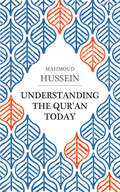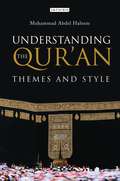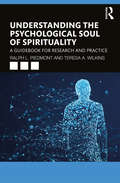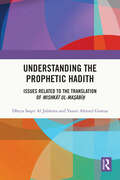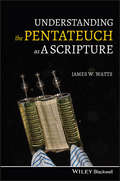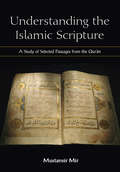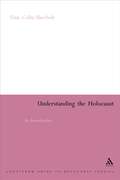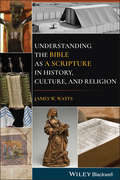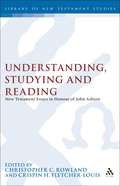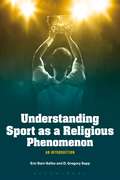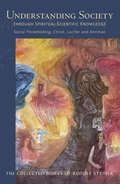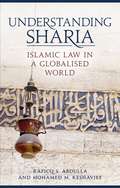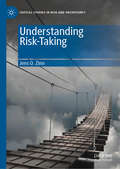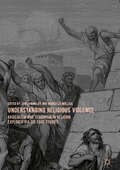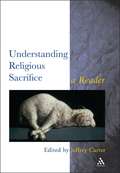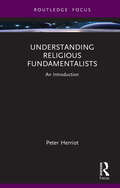- Table View
- List View
Understanding the Qur'an Today
by Mahmoud HusseinThe prevailing belief among Muslims is that, because the Qur'an is the Word of God and God is eternal, it follows that His Word is also eternal. The belief is based on the postulate that the Word of God must be of the same nature as God Himself. Mahmoud Hussein refutes this by showing that it contradicts the very teachings of the Qur'an. Whereas God transcends time, His Word is inscribed within time. It is not a monologue, but a living exchange, through which God reveals to His Prophet different orders of truth, weaving together the absolute and the relative, the general and the particular, the eternal and the contingent. An international bestseller, Understanding the Qur'an today offers a new perspective on one of the world's most influential texts and adds an invaluable contribution to the debate on Islam and modernity.
Understanding the Qur'an: Themes and Style
by Muhammad Abdel Haleem M. A. HaleemThe tenets of Islam cannot be grasped without a proper understanding of the Qur'an. In this important new introduction, Muhammad Haleem examines its recurrent themes - life and eternity, marriage and divorce, peace and war, water and nourishment - and for the first time sets these in the context of the Qur'an's linguistic style. Professor Haleem examines the background to the development of the surahs (chapters) and the ayahs (verses) and the construction of the Qur'an itself. He shows that popular conceptions of Islamic attitudes to women, marriage and divorce, war and society, differ radically from the true teachings of the Qur'an.
Understanding the Qur'an: Themes and Style (London Qur'an Studies)
by Muhammad Abdel Haleem M. A. HaleemNEW PAPERBACK EDITION OF THE HIGHLY ACCLAIMED GUIDE TO THE QUR'AN AND ITS INTERPRETATION BY A WORLD AUTHORITY ON ISLAMThe tenets of Islam cannot be grasped without a proper understanding of theQur'an. In this important introduction, now revised and updated for a newpaperback edition, Muhammad Abdel Haleem examines the Qur'an's majorrecurrent themes - life and eternity, marriage and divorce, peace and war, waterand nourishment - and for the first time considers these elements in thecontext of Qur'anic linguistic style. With a fresh insight into the background ofthe Qur'an, Professor Haleem examines the context and circumstances leadingto the development of the suras (chapters) and the ayahs (verses) and theconstruction of the Qur'an itself. He shows that popular conceptions of Islamicattitudes to women, marriage and divorce, conflict and society, all differ radicallyfrom the true teachings of the Qur'an. Understanding the Qur'angoes on toexplore the ways in which the Judaic and Christian traditions, as reflected in theBible, may be compared to Qur'anic approaches to similar themes.
Understanding the Psychological Soul of Spirituality: A Guidebook for Research and Practice
by Ralph L. Piedmont Teresa A. WilkinsUnderstanding the Psychological Soul of Spirituality is a comprehensive exploration of spiritual constructs based on an empirical, evidence-based paradigm for understanding and addressing spirituality. In a field where there is no current consensus on spirituality, this book provides a much-needed psychologically based definition and ontology that assists helping professionals in formulating their professional identities; developing effective and appropriate training models; furthering their understanding of what spirituality is and is not, from a psychological perspective; and more effectively addressing spiritual issues to support clients. The authors provide a review of current issues in the area of spirituality, also called the numinous, and provide perspectives that address these concerns in ways that promote a fully scientific understanding of the construct. Ultimately the book provides a concise definition of the numinous that places it squarely in the social sciences. Chapters outline the clear value of the numinous for psychology and detail its relevance for professionals’ training.
Understanding the Psychological Soul of Spirituality: A Guidebook for Research and Practice
by Ralph L. Piedmont Teresa A. WilkinsUnderstanding the Psychological Soul of Spirituality is a comprehensive exploration of spiritual constructs based on an empirical, evidence-based paradigm for understanding and addressing spirituality. In a field where there is no current consensus on spirituality, this book provides a much-needed psychologically based definition and ontology that assists helping professionals in formulating their professional identities; developing effective and appropriate training models; furthering their understanding of what spirituality is and is not, from a psychological perspective; and more effectively addressing spiritual issues to support clients. The authors provide a review of current issues in the area of spirituality, also called the numinous, and provide perspectives that address these concerns in ways that promote a fully scientific understanding of the construct. Ultimately the book provides a concise definition of the numinous that places it squarely in the social sciences. Chapters outline the clear value of the numinous for psychology and detail its relevance for professionals’ training.
Understanding the Prophetic Hadith: Issues Related to the Translation of Mishkāt ul-Maṣābīḥ
by Dheya Saqer Al Jalahma Yasser Ahmed GomaaThis book examines two English translations of Mishkāt ul-Maṣābīḥ by Al-Tabrīzī and reflects on some of the key issues relating to Hadith translation. The highly instructional nature of the Prophetic Hadith means that the comprehensibility of any translation is of great importance to a non-Arabic-speaking Muslim, and there is a need to analyze available translations to determine whether these texts can function properly in the target culture. The volume considers the relevance of skopos theory, the concept of loyalty, and the strategies of the translators in question. There are also chapters that focus on the translation of Islamic legal terms and metaphors related to women, formulaic expressions, and reported nonverbal behavior in Fazlul Karim’s (1938) and Robson’s (1960) versions of the text.
Understanding the Prophetic Hadith: Issues Related to the Translation of Mishkāt ul-Maṣābīḥ
by Dheya Saqer Al Jalahma Yasser Ahmed GomaaThis book examines two English translations of Mishkāt ul-Maṣābīḥ by Al-Tabrīzī and reflects on some of the key issues relating to Hadith translation. The highly instructional nature of the Prophetic Hadith means that the comprehensibility of any translation is of great importance to a non-Arabic-speaking Muslim, and there is a need to analyze available translations to determine whether these texts can function properly in the target culture. The volume considers the relevance of skopos theory, the concept of loyalty, and the strategies of the translators in question. There are also chapters that focus on the translation of Islamic legal terms and metaphors related to women, formulaic expressions, and reported nonverbal behavior in Fazlul Karim’s (1938) and Robson’s (1960) versions of the text.
Understanding the Pentateuch as a Scripture
by James W. WattsA cutting-edge scholarly review of how the Pentateuch functions as a scripture, and how it came to be ritualized in this way. Understanding the Pentateuch as a Scripture is a unique account of the first five books of the Bible, describing how Jews and Christians ritualize the Pentateuch as a scripture by interpreting it, by performing its text and contents, and by venerating the physical scroll and book. Pentateuchal studies are known for intense focus on questions of how and when the first five books of the Bible were composed, edited, and canonized as scripture. Rather than such purely historical, literary, or theological approaches, Hebrew Bible scholar James W. Watts organizes this description of the Pentateuch from the perspectives of comparative scriptures and religious studies. He describes how the Pentateuch has been used in the centuries since it began to function as a scripture in the time of Ezra, and the origins of its ritualization before that time. The book: Analyzes the semantic contents of the Pentateuch as oral rhetoric that takes the form of stories followed by lists of laws and sanctions Gives equal space to its ritualization in the iconic and performative dimensions as to its semantic interpretation Fully integrates the cultural history of the Pentateuch and Bible with its influence on Jewish and Christian ritual, and in art, music, theatre, and film Understanding the Pentateuch as a Scripture is a groundbreaking work that highlights new research data and organizes the material to focus attention on the Pentateuch’s—and Bible’s— function as a scripture.
Understanding the Pentateuch as a Scripture
by James W. WattsA cutting-edge scholarly review of how the Pentateuch functions as a scripture, and how it came to be ritualized in this way. Understanding the Pentateuch as a Scripture is a unique account of the first five books of the Bible, describing how Jews and Christians ritualize the Pentateuch as a scripture by interpreting it, by performing its text and contents, and by venerating the physical scroll and book. Pentateuchal studies are known for intense focus on questions of how and when the first five books of the Bible were composed, edited, and canonized as scripture. Rather than such purely historical, literary, or theological approaches, Hebrew Bible scholar James W. Watts organizes this description of the Pentateuch from the perspectives of comparative scriptures and religious studies. He describes how the Pentateuch has been used in the centuries since it began to function as a scripture in the time of Ezra, and the origins of its ritualization before that time. The book: Analyzes the semantic contents of the Pentateuch as oral rhetoric that takes the form of stories followed by lists of laws and sanctions Gives equal space to its ritualization in the iconic and performative dimensions as to its semantic interpretation Fully integrates the cultural history of the Pentateuch and Bible with its influence on Jewish and Christian ritual, and in art, music, theatre, and film Understanding the Pentateuch as a Scripture is a groundbreaking work that highlights new research data and organizes the material to focus attention on the Pentateuch’s—and Bible’s— function as a scripture.
Understanding the Islamic Scripture
by Mustansir MirThis book makes the Qur'an accessible to the English-speaking student who lacks the linguistic background to read it in the original Arabic by offering accessible translations of, and commentary on, a series of selected passages that are representative of the Islamic scripture. Mustanstir Mir, Director of the Center for Islamic Studies at Youngstown State University, offers clear translations and analysis of 35 selected passages of the Qur'an that will help students understand what kind of book the Qur'an is, what the scripture says, and how it says it.
Understanding the Islamic Scripture
by Mustansir MirThis book makes the Qur'an accessible to the English-speaking student who lacks the linguistic background to read it in the original Arabic by offering accessible translations of, and commentary on, a series of selected passages that are representative of the Islamic scripture. Mustanstir Mir, Director of the Center for Islamic Studies at Youngstown State University, offers clear translations and analysis of 35 selected passages of the Qur'an that will help students understand what kind of book the Qur'an is, what the scripture says, and how it says it.
Understanding the 'Imago Dei': The Thought of Barth, von Balthasar and Moltmann
by Dominic RobinsonAs theologians across confessional divides try to say something significant about human dignity in our contemporary society, there is fresh interest in the ancient Christian doctrine that the human being is created in the 'imago Dei'. Theology is grounding responsibility for others and for the world around us in this common vision that the human being's infinite horizon lies in a divine calling and destiny. Robinson examines the 'imago Dei' debate through three giants of twentieth century theology - Karl Barth, Hans Urs von Balthasar, and Jürgen Moltmann. This is placed against a survey of the principle developments and distinctions relating to the doctrine in the history of Christian thought, which in itself will be valuable for all students of Theology. A fresh analysis of ecumenical contributions places the development of the doctrine in the context of the ongoing process of ecumenical dialogue on the dignity of the human person, with special reference to this theme in the first encyclical of Pope Benedict XVI, Deus Caritas Est. Whilst 'imago Dei' is the focus of this book, Robinson invites the reader to see its relevance to theology as a whole on a specifically ecumenical canvas, and relates directly to more general areas of theological anthropology, grace, salvation, and the relationship between God and the world.
Understanding the 'Imago Dei': The Thought of Barth, von Balthasar and Moltmann
by Dominic RobinsonAs theologians across confessional divides try to say something significant about human dignity in our contemporary society, there is fresh interest in the ancient Christian doctrine that the human being is created in the 'imago Dei'. Theology is grounding responsibility for others and for the world around us in this common vision that the human being's infinite horizon lies in a divine calling and destiny. Robinson examines the 'imago Dei' debate through three giants of twentieth century theology - Karl Barth, Hans Urs von Balthasar, and Jürgen Moltmann. This is placed against a survey of the principle developments and distinctions relating to the doctrine in the history of Christian thought, which in itself will be valuable for all students of Theology. A fresh analysis of ecumenical contributions places the development of the doctrine in the context of the ongoing process of ecumenical dialogue on the dignity of the human person, with special reference to this theme in the first encyclical of Pope Benedict XVI, Deus Caritas Est. Whilst 'imago Dei' is the focus of this book, Robinson invites the reader to see its relevance to theology as a whole on a specifically ecumenical canvas, and relates directly to more general areas of theological anthropology, grace, salvation, and the relationship between God and the world.
Understanding the Holocaust: An Introduction (Issues in Contemporary Religion)
by Dan Cohn-SherbokWhat is the Holocaust? Were Hitler and his executioners sadistic psychopaths? Were ordinary Germans morally culpable for murdering millions of innocent victims? This volume seeks to explore these and other ethical, cultural, and religious questions within a historical context. Beginning with the origin and growth of anti-Semitism, the book continues with a detailed account of the various stages of Nazi onslaught and concludes with a consideration of the legacy of the Holocaust in the modern world.Designed as a work for students in colleges and universities as well as the general reader, the volume contains 26 chapters which deal with a particular period. This is followed by discussion of the implication of the events of the Holocaust. Unlike other books on the subject, this study contains both a history of the Holocaust and extensive reflections about social, religious, and moral issues raised by the emergence of the Third Reich and its impact on subsequent history.Contains maps and illustrations related to the growth and development of Nazism and a lengthy bibliography for further study.
Understanding the Bible as a Scripture in History, Culture, and Religion
by James W. WattsUNDERSTANDING THE BIBLE AS A SCRIPTURE IN HISTORY, CULTURE, AND RELIGION The Bible is a popular subject of study and research, yet biblical studies gives little attention to the reason for its popularity: its religious role as a scripture. Understanding the Bible as a Scripture in History, Culture, and Religion integrates the history of the religious interpretation and ritual uses of biblical books into a survey of their rhetoric, composition, and theology in their ancient contexts. Emphasizing insights from comparative studies of different religious scriptures, it combines discussion of the Bible’s origins with its cultural history into a coherent understanding of its past and present function as a scripture.A prominent expert on biblical rhetoric and the ritualization of books, James W. Watts describes how Jews and Christians ritualize the Bible by interpreting it, by expressing it in recitations, music, art, and film, and by venerating the physical scroll and book. The first two sections of the book are organized around the Torah and the Gospels—which have been the focus of Jewish and Christian ritualization of scriptures from ancient to modern times—and treat the history of other biblical books in relation to these two central blocks of the Hebrew Bible and New Testament. In addition to analyzing the semantic contents of all the Bible’s books as persuasive rhetoric, Watts describes their ritualization in the iconic and expressive dimensions in the centuries since they began to function as a scripture, as well as in their origins in ancient Judaism and Christianity. The third section on the cultural history and scriptural function of modern bibles concludes by discussing their influence today and the controversies they have fueled about history, science, race, and gender. Innovative and insightful, Understanding the Bible as a Scripture in History, Culture, and Religion is a groundbreaking introduction to the study of the Bible as a scripture, and an ideal textbook for courses in biblical studies and comparative scripture studies.
Understanding the Bible as a Scripture in History, Culture, and Religion
by James W. WattsUNDERSTANDING THE BIBLE AS A SCRIPTURE IN HISTORY, CULTURE, AND RELIGION The Bible is a popular subject of study and research, yet biblical studies gives little attention to the reason for its popularity: its religious role as a scripture. Understanding the Bible as a Scripture in History, Culture, and Religion integrates the history of the religious interpretation and ritual uses of biblical books into a survey of their rhetoric, composition, and theology in their ancient contexts. Emphasizing insights from comparative studies of different religious scriptures, it combines discussion of the Bible’s origins with its cultural history into a coherent understanding of its past and present function as a scripture.A prominent expert on biblical rhetoric and the ritualization of books, James W. Watts describes how Jews and Christians ritualize the Bible by interpreting it, by expressing it in recitations, music, art, and film, and by venerating the physical scroll and book. The first two sections of the book are organized around the Torah and the Gospels—which have been the focus of Jewish and Christian ritualization of scriptures from ancient to modern times—and treat the history of other biblical books in relation to these two central blocks of the Hebrew Bible and New Testament. In addition to analyzing the semantic contents of all the Bible’s books as persuasive rhetoric, Watts describes their ritualization in the iconic and expressive dimensions in the centuries since they began to function as a scripture, as well as in their origins in ancient Judaism and Christianity. The third section on the cultural history and scriptural function of modern bibles concludes by discussing their influence today and the controversies they have fueled about history, science, race, and gender. Innovative and insightful, Understanding the Bible as a Scripture in History, Culture, and Religion is a groundbreaking introduction to the study of the Bible as a scripture, and an ideal textbook for courses in biblical studies and comparative scripture studies.
Understanding, Studying and Reading: New Testament Essays in Honour of John Ashton (The Library of New Testament Studies #153)
by Christopher Rowland Crispin H. Fletcher-LouisThis collection of essays, largely written by members of the Oxford theological community, was presented to John Ashton on his 65th birthday in 1996. The essays deal with Elijah in Mark, a Q passion narrative, the Gospel thief saying, John's Beloved Disciple, the temple incident (Jn 2.13-25) and history and theology. Outside of the Gospels, they discuss God's wrath in Romans 1, Philippians 1.1-11, Hebrews 4.13, Peter and Paul behind Revelation, and hermeneutical method. Specialists from outside the New Testament field contribute studies of the patristic doctrine of Scripture, the Syriac Diatessaron, William Tyndale, the theology of the resurrection and the Byzantine understanding of John. John Ashton was, before his retirement, Lecturer in New Testament and Fellow of Wolfson College, Oxford.
Understanding Sport as a Religious Phenomenon: An Introduction
by Eric Bain-Selbo D. Gregory SappReaders are introduced to a range of theoretical and methodological approaches used to understand religion – including sociology, philosophy, psychology, and anthropology – and how they can be used to understand sport as a religious phenomenon. Topics include the formation of powerful communities among fans and the religious experience of the fan, myth, symbols and rituals and the sacrality of sport, and sport and secularization. Case studies are taken from around the world and include the Olympics (ancient and modern), football in the UK, the All Blacks and New Zealand national identity, college football in the American South, and gymnastics.Ideal for classroom use, Understanding Sport as a Religious Phenomenon illuminates the nature of religion through sports phenomena and is a much-needed contribution to the field of religion and popular culture.
Understanding Sport as a Religious Phenomenon: An Introduction
by Eric Bain-Selbo D. Gregory SappReaders are introduced to a range of theoretical and methodological approaches used to understand religion – including sociology, philosophy, psychology, and anthropology – and how they can be used to understand sport as a religious phenomenon. Topics include the formation of powerful communities among fans and the religious experience of the fan, myth, symbols and rituals and the sacrality of sport, and sport and secularization. Case studies are taken from around the world and include the Olympics (ancient and modern), football in the UK, the All Blacks and New Zealand national identity, college football in the American South, and gymnastics.Ideal for classroom use, Understanding Sport as a Religious Phenomenon illuminates the nature of religion through sports phenomena and is a much-needed contribution to the field of religion and popular culture.
UNDERSTANDING SOCIETY: Through Spiritual-Scientific Knowledge. Social Threefolding, Christ, Lucifer and Ahriman
by Rudolf SteinerIn the uncertainty following the end of the First World War, Rudolf Steiner perceived a unique opportunity to establish a healthy social and political constitution. He began lecturing throughout post-war Germany, often to large audiences, about his social ideas. Here, speaking to a more intimate grouping at the Goetheanum in Dornach, Switzerland, Steiner seeks to deepen the themes of social threefolding, showing specifically how new social thinking is integral to anthroposophy.Steiner speaks of the superficiality of the materialistic view of history, originating with the economic shift amongst the population at the time of the Reformation. Back in Egyptian-Chaldean times, initiates ruled out of spiritual impulses. Later, in the Greco-Roman period, priests had power over their congregations. Today, homo economicus – or ‘economic man’ – has become the dominant idea, with the capitalist and the banker taking control. But the healing of social relationships can only come about through different modes of thought; the life of spirit must be separated not only from politics but also from economics. True social understanding allows for comprehension of karma – the appreciation of each person’s individual destiny. In parallel, says Steiner, we should work towards a global consciousness, as true social ideas are founded on people feeling themselves to be citizens of the world.In an important corollary, Steiner studies the incarnations of three significant spiritual beings in human evolution: Lucifer, Christ and Ahriman. Lucifer incarnated in the third pre-Christian millennium, Christ incarnated at the dawn of a new age, whilst an incarnation of Ahriman in the West is immanent. Ahriman is preparing this incarnation by insidiously promoting various ideas, for example that economic security is sufficient for healthy public life. A new wisdom must be achieved out of free human will, says Steiner, or else we will succumb to Ahriman.
Understanding Sharia: Islamic Law in a Globalised World
by Mohamed M. Keshavjee Raficq S. AbdullaSharia has been a source of misunderstanding and misconception in both the Muslim and non-Muslim worlds. Understanding Sharia: Islamic Law in a Globalised World sets out to explore the reality of sharia, contextualising its development in the early centuries of Islam and showing how it evolved in line with historical and social circumstances. The authors, Raficq S. Abdulla and Mohamed M. Keshavjee, both British-trained lawyers, argue that sharia and the positive law flowing from it, known as fiqh, have never been an exclusive legal system or a fixed set of beliefs.
Understanding Risk-Taking (Critical Studies in Risk and Uncertainty)
by Jens O. ZinnThis book outlines and systematises findings from a growing body of research that examines the different rationales, dimensions and dynamics of risk-taking in current societies; providing insight into the different motivations and social roots of risk-taking to advance scholarly debates and improve social regulation. Conceptually, the book goes beyond common approaches which problematise socially undesirable risk-taking, or highlight the alluring character of risk-taking. Instead, it follows a broadly interpretivist approach and engages in examining motives, control, routinisation, reflexivity, skills, resources, the role of identity in risk-taking and how these are rooted in and framed by different social forces. Zinn draws on qualitative studies from different theoretical and conceptual backgrounds such as phenomenology, hermeneutics, pragmatism, feminism, class analysis, theory of practice and discourse analysis among others, to outline key distinctions and concepts central to the understanding of risk-taking. It will be a key resource for everyone who is concerned with the understanding and management of risk-taking in all kinds of social domains, such as immigration, youth, leisure sports, crime, health, finance, and social policy.
Understanding Religious Violence: Radicalism and Terrorism in Religion Explored via Six Case Studies
by James Dingley Marcello MollicaThis book addresses the problem of religiously based conflict and violence via six case studies. It stresses particularly the structural and relational aspects of religion as providing a sense of order and a networked structure that enables people to pursue quite prosaic and earthly concerns. The book examines how such concerns link material and spiritual salvation into a holy alliance. As such, whilst the religions concerned may be different, they address the same problems and provide similar explanations for meaning, success, and failure in life. Each author has conducted their own field-work in the religiously based conflict regions they discuss, and together the collection offers perspectives from a variety of different national backgrounds and disciplines.
Understanding Religious Sacrifice: A Reader (Controversies in the Study of Religion)
by Jeffrey CarterThis volume provides a thorough introduction to the major classic and modern writings dealing with religious sacrifice. Collected here are twenty five influential selections, each with a brief introduction addressing the overall framework and assumptions of its author. As they present different theories and examples of sacrifice, these selections also discuss important concepts in religious studies such as the origin of religion, totemism, magic, symbolism, violence, structuralism and ritual performance. Students of comparative religion, ritual studies, the history of religions, the anthropology of religion and theories of religion will particularly value the historical organization and thematic analyses presented in this collection.
Understanding Religious Fundamentalists: An Introduction (Routledge Focus on Religion)
by Peter HerriotThis book introduces the prominent role that fundamentalists play in religious, cultural, and political arenas.It begins by investigating religious fundamentalist groups and their psychological motivations for this counter-cultural adherence. Their extremely varied actions, argues the author, are based on two fundamental beliefs: that God speaks to them personally through his Word; and that they are involved in a cosmic war between God and Satan.. Subsequent chapters explore how fundamentalisms meet universal psychological needs for meaning, identity, agency, and self-esteem. Moving from individual psychology to social context, the latter half of the book explores how fundamentalist movements derive and exercise their authority and how leaders may strategise to appeal to external societies. The closing chapters seek to place the growth of fundamentalisms and their continued popularity in the social context of modernity and populism.With engaging discussion questions and suggestions for further reading, this book is ideal for students of social science and religion, as well as readers interested in the psychological roots of fundamentalism.
